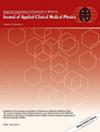Performance evaluation and quantitative comparison of two 4DCT imaging respiratory systems using deformable image registration
Abstract
Purpose
Improved accuracy in 4DCT imaging and precise targeting of tumors contribute to more effective and targeted radiation therapy. This study focuses on evaluating the accuracy of utilizing the GateCT (VisionRT Ltd, London, United Kingdom) in comparison with a pressure sensor system (ANZAI Medical Co., Ltd., Shinagawa, Tokyo) to provide 4DCT with respiratory information.
Methods
A dynamic breathing phantom enclosing three spheres (A, P, and R) of different densities was enrolled to produce breathing patterns tracked by the two systems. Image sets for three breathing phases obtained based on GateCT and ANZAI systems were analyzed using deformable registration by deforming the three-phase image sets with the static image sets. Our deformable registration approach revealed how far different phase image sets were from the quantified by various metrics, such as dice similarity coefficient (DSC), mean surface distance (MSD), absolute volume estimation, mean Jacobian, and Warp.
Results
Results indicated DSC values greater than 0.90 across all phases and spheres for both respiratory systems, with mean DSC values for spheres A, P, and R of 0.980 versus 0.977, 0.977 versus 0.976, and 0.977 versus 0.976 for GateCT and ANZAI systems, respectively. MSDs for both systems were consistently less than 2 mm across all spheres and phases. Furthermore, the mean volume estimation error for both systems, relative to the static, exhibited statistical insignificance (p > 0.05). Friedman test revealed significant differences in median Jacobian, and median Warping between the two systems (p < 0.05).
Conclusions
In addition to the effectiveness of deformable image registration in the quantification of respiratory system performance, both systems exhibited comparable performance in providing 4DCT with respiratory information.


 求助内容:
求助内容: 应助结果提醒方式:
应助结果提醒方式:


